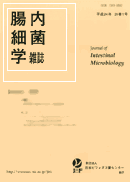All issues

Volume 26 (2012)
- Issue 4 Pages 211-
- Issue 3 Pages 159-
- Issue 1 Pages 3-
Predecessor
Volume 26, Issue 3
Displaying 1-3 of 3 articles from this issue
- |<
- <
- 1
- >
- >|
Review
-
Masao HATTORI2012 Volume 26 Issue 3 Pages 159-169
Published: 2012
Released on J-STAGE: August 11, 2012
JOURNAL FREE ACCESSSince Kampo medicines are orally administered in general, their constituents are metabolized by anaerobic bacteria in the gastrointestinal tract. In particular, glycosides are hardly absorbed in the upper intestine and are transported to the lower intestine, where some of them are metabolized to medicinally active compounds.
In this review, we focus on the current topics including transformation of anthraquinones into ultimate purgative substances and cleavage of C- and O-glycosides. Finally, we show a list of the significant studies on the bacterial transformation of constituents of Kampo medicines, which were mostly carried out in our laboratory.
View full abstractDownload PDF (1160K) -
Jong-Sik JIN2012 Volume 26 Issue 3 Pages 171-181
Published: 2012
Released on J-STAGE: August 11, 2012
JOURNAL FREE ACCESSMicrobial cells that outnumber the eukaryotic cell population of the host by a factor of 10 inhabit the human intestine and affect human health. One of the effects of human intestinal bacteria on health is metabolism of dietary constituents and medicines. Lignan can be an example of activation by human intestinal bacteria. Lignans are diphenylpropanoid compounds widely distributed in edible plants such as grains, seeds, fruits and vegetables. Based on their estrogen-like characteristics, plant lignans have been classified as phytoestrogens with isoflavones. However, most plant lignans themselves do not show estrogenic activities. Only after being converted by intestinal bacteria, are they biologically activated. Plant lignans are transformed into mammalian lignans, enterolactone and enterodiol, by human intestinal bacteria. The metabolic pathways of intestinal bacteria have been verified, and some bacteria participating in biotransformation were isolated. This report reviews biotransformation of plant lignans and biological activities of mammalian lignans, focusing on metabolic characteristics of intestinal bacteria.
View full abstractDownload PDF (1081K)
Full Paper
-
Tsuyoshi MINEMURA, Kazuki NUKUI, Akihito TOMONAGA2012 Volume 26 Issue 3 Pages 183-187
Published: 2012
Released on J-STAGE: August 11, 2012
JOURNAL FREE ACCESSA chitosan-coated capsule was developed with the aim of delivering bifidobacteria directly to the large intestine, where the bacteria naturally inhabit, by protecting them from gastric acid. A capsule dissolution experiment was conducted using beta carotene as the content; the capsules were first immersed in Solution I, which simulated gastric juice, and slight dissolution was confirmed after 60 minutes. Then they were immersed Solution II which simulated the environment of the small intestine, and a dissolution rate of approximately 3% was confirmed during immersion for 120 minutes. Finally, they were immersed in a pH 3.5 solution to see whether there was any change in the solubility of the chitosan film, and a dissolution rate close to 100% was reached within 60 minutes. These results showed that the capsule was likely to disintegrate in the large intestine as intended. With this finding, an experiment was conducted to confirm the region in the human digestive system where the capsule disintegrates. For this experiment, the capsules were filled with barium sulfate and coated with chitosan and acid-resistant films. In one subject, the capsule remained in the duodenum, and disintegration was not confirmed during the observation period. This may have been due to the capsule remaining in the stomach and the duodenum for a long time for unknown reasons. In the remaining five subjects, the capsule disintegrated in the large or small intestine, and in all of the subjects, it was considered that the capsule started disintegrating between 4.0 and 7.5 hours after ingestion. It was also judged that the capsule completely disintegrated between 5.0 and 8.5 hours after ingestion. Considering how the human digestion system works, these results suggest that the capsule is acid resistant and can reach the large intestine via the small intestine without disintegration. With regard to the case in which the capsule disintegrated in the small intestine, it was believed that the capsule’s retention time in the stomach, as well as in the small intestine, was extended due to the high specific gravity of the capsule, which was filled with barium sulfate, and as a result, it disintegrated in the small intestine due to physical stimuli such as peristalsis.
This study showed that the chitosan-coated capsule we developed has disintegration properties different from conventional capsules, is acid resistant and is likely to disintegrate in the large intestine when filled with bifidobacteria.
View full abstractDownload PDF (1383K)
- |<
- <
- 1
- >
- >|